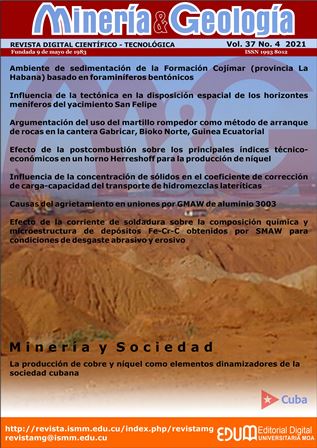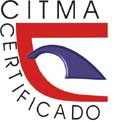Sedimentation environment of the Cojimar Formation (Havana province) based on benthic foraminifera
Keywords:
paleoecology, foraminifera, Miocene, Cojímar Formation, Cuba.Abstract
Cojímar Formation, —Lower Miocene (upper part) to Middle Miocene (lower part)—, is a unit in Western Cuba well known for its extensive development and exposure outcrops. It has been widely used in bioestratigraphic studies. However, paleoecological studies on this unit through foraminifera, both planktonic and benthic species, are considered insufficient. The richness and variety of microfossils, especially foraminifera, has allowed us to address the paleoecological aspect. In this paper, the sedimentary environment is established. Besides the systematic classification of these species was updated and the biozonation re-evaluated from planktonic foraminifera. A detailed sampling, from material taken every 15 meters was fulfilled along with a compilation of all species of foraminifera reported for the studied unit. The micropalaeontological analysis allowed the identification of 40 taxa of planktonic foraminifera grouped into 12 genera, being the most representative Globigerina, Globigerinoides, Orbulina, and Globorotalia. Moreover, 226 taxa of benthic foraminifera belonging to 102 genera were determined. These included: Lituolida, Loftusiida, Textulariida, Lagenida, Rotaliida and Miliolida suborders. The main genres represented were Cibicides, Cibicidoides, Cibicobis, Uvigerina, Angulogerina, Anomalinoides, Planulina, Bolivina, Amphistegina, Lenticulina, Nodosaria, and Textularia. Cojímar Formation corresponds to a deep platform, which was determined from the benthic microforaminifera (Uvigerina, Lenticulina, Marginulina) analyzed. Thanatocenoses developed in outer neritic to upper bathyal depths between 100 m - 500m. New reports of both planktonic foraminifera species for that unit as small benthic, such as Anomalinoides flintii, A. trinitatensis, Planulina valued cf. P. mantaensis, Catapsydrax cf. C. dissimilis, Globigerinoides cf. G. obliquus, Globigerinoides primordius, and Hastigerina praesiphonifera were evaluated. As a contribution Gyroidinoides cibaoensis taxon is here first reported to Cuba.Downloads
References
Aubry, M.P. & Berggren, W.A. 2011: Course presented at PDVSA, El Chaure, on Applied Micropaleontology, 31 October to 4 November.
Albear, J.F. De & Iturralde-Vinent, M. 1985: Estratigrafía de las provincias de La Habana. En: Contribución a la Geología de las provincias de La Habana y Ciudad de La Habana. La Habana: Editorial Cientifico Técnica, p. 12 - 54.
Bermúdez, P.J. 1949: Tertiary Smaller Foraminifera of the Dominican Republic. Cushman Laboratory for Foraminiferal Research, Special Publications. 25: 1-322.
Bermúdez, P.J. 1950: Contribución al estudio del Cenozoico Cubano: Memorias de la Sociedad Cubana Historia Natural. 19(3): 205-375.
Bermúdez, P.J. 1961: Contribución al estudio de las Globigerinidea de la región Caribe - Antillana (Paleoceno - Reciente): Memoria del III Congreso Geológico Venezolano, 3. Boletín de Geología, Publicación Especial : 1119 – 1393.
Bhaumik, A.K., Gupta, A.K., Sundar, R.M., Mohan, K., Soma De & Sarkar, S. 2007: Paleoceanographic evolution of the northeastern Indian Ocean during the Miocene: Evidence from deep-sea benthic foraminifera (DSDP Hole 216A). Indian Journal of Marine Sciences, 36(4): 332-341.
Boersma, A. 1998: Calcareous Microfossils. Foraminifera. En: Haq, U.B., Boersma, A. Introduction to Marine Micropaleontology, Elsevier, p. 19-77.
Bolli, H.M., Saunders, J.B. & Perch-Nielsen, K. 1985: Plankton Stratigraphy. Cambridge: Cambridge University Press, 597 pp.
Bolli, H.M., Beckmann, J.P. & Saunders, J.B., 1994: Benthic foraminiferal biostratigraphy of the south Caribbean region. Cambridge: Cambridge University Press, 408 pp.
Boudagher-Fadel, M. 2013: The Cenozoic planktonic foraminifera: The Neogene. In Biostratigraphic and Geological Significance of Planktonic Foraminifera. London: UCL Press. 203-270.<http://dx.doi.org/10.14324/99.1>, consulta: Marzo, 2020.
Bronnimann, P. & Rigassi, D. 1963: Contribution to the geology and paleontology of the area of the city of La Habana, Cuba and its surroudings, Eclogae Geologicae Helvetiae. 56(1): 193-430.
Corbí, H.A. 2010: Los foraminíferos de la Cuenca Neógena del Bajo Segura (Sureste de España): Bioestratigrafía y cambios paleoambientales en relación con la crisis de salinidad del Mediterráneo. Tesis de Doctorado. Universidad de Alicante. España , consulta: Marzo, 2020.
De Huelbes, J. 2013: Léxico Estratigráfico de Cuba. Centro Nacional de Información Geológica (CNDIG). La Habana. 573 p. ISBN: 978-959-7117-58-2.
De Rijk, S., Troelstra, S.R. & Rohling, E.J. 1999: Benthic foraminiferal distribution in the Mediterranean Sea. Journal of Foraminiferal Research. 29: 93–103.
Dominguez-Samalea, Y., Pérez, E.L.M. & Rojas, R. 2015: Paleoecología de los foraminíferos en la Formación Cojímar, provincia Habana, Cuba. En: XI Congreso Cubano de Geología Estratigrafía y Paleontología. Memorias. La Habana, Cuba, 4-8 mayo, 635- 672.
Drinia, H. Antonarakou, A., Tsaparas, N. & Dermitzakis, M.D. 2007: Foraminiferal stratigraphy and palaeoecological implications in turbidite-like deposits from the Early Tortonian (Late Miocene) of Greece. Journal of Micropaleontology. 26: 145-158.
Enclycopledia of Life. Available from http://eol.org. Accesed 15 February 2020.
Gebhardt, H. 1999: Middle to Upper Miocene benthonic foraminiferal palaeoecology of the Tap Marls (Alicante Province, SE Spain) and its palaeoceanographic implications. Palaeogeography, Palaeoclimatology, Palaeoecology. 145: 141-156.
Gupta, A.K. & Thomas, E. 1999: Latest Miocene–Pleistocene productivity and deep-seaventilation in the northwestern Indian Ocean (DSDP Site 219). Paleoceanography. 14: 62–73.
Gupta, A.K., Sundar Raj, M., Mohan, K. & De, S. 2008: A major change in monsoon-drivenproductivity in the tropical Indian Ocean during ca 1.2–0.9 Myr: foraminiferalfaunal and stable isotope data. Palaeogeography, Palaeoclimatology, Palaeoecology. 261: 234–245.
Ellis, B.F. & Messina, A.R. 1940: Catalogue of Foraminifera (and supplements). Special Publications American Museum of Natural History. Micropaleontology Press.
Franco, G.L. et al. 1992: Léxico Estratigráfico de Cuba. La Habana. Editorial Centro de Nacional de Información Geológica.
Franco, G.L. & Delgado, R.D. 1998: Sistema Neógeno, en: Furrazola-Bermúdez, G., Núñez-Cambra, K., (Editores). Estudios sobre Geología de Cuba. La Habana. Instituto de Geología y Paleontología. Centro Nacional de Información Geológica.
Gupa, A.K., Singh, R.K. & Verma, S. 2013: Deep-sea palaeoceanographic evolution ofthe Eastern Indian Ocean during the late Oligocene-Pleistocene: species diversity trends in benthic foraminifera. Current Science, 104(7): 1-7.
Hayward, B.W., Le Coze, F., Vachard, D. & Gross, O. 2019: World Foraminifera Database. Globorotalia (Globorotalia) cultrata (d'Orbigny, 1839). Accessed through: World Register of Marine Species at: http://marinespecies.org/aphia.php?p=taxdetails&id=926313 on 2019-12-06
Hayward, B.W, Le Coze, F., Vachard, D., Gross, O. 2020: World Foraminifera Database. Accessed at http://www.marinespecies.org/foraminifera on 2020-09-01. doi:10.14284/305
Hesemann, M. 2021: In: Hesemann, M. 2020: Foraminifera.eu Project Database. Accessed at http://www.foraminifera.eu/single.php?no=&aktion=suche on 2020-3-3
Holbourn, A., Henderson, A.S. & Macleod, N. 2013: Atlas of Benthic Foraminifera, <http://bookzz.org/book/2149772/6712c9>, consulta: Febrero, 2020.
Hohenegger, J., Rögl, F., Ćorić, S., Pervesler, P., Lirer, F., Roetzel, R., Scholger, R. & Stingl, K. 2009: The Styrian Basin: a key to the Middle Miocene (Badenian/Langhian) Central Paratethys transgressions. Austrian Journal of Earth Sciences, 102:102-132.
Holcová, K. & Zágoršek, K. 2008: Bryozoa, Foraminifera and calcareous nannoplankton as environmental proxies of the “bryozoan event” in the Middle Miocene of the Central Paratethys (Czech Republic). Palaeogeography, Palaeoclimatology, Palaeoecology, 267(3): 216-234.
http://gni.globalnames.org/, consulta: Febrero, 2020.
http://www.biodiversitylibrary.org/, consulta: Febrero, 2020.
http://www.ecosis.cu/biocuba/biodiversidadcuba/03_protozoa/protozoa.htm, consulta: Febrero, 2020.
Iaccarino, S.M., Premoli-Silva, I., Biolzi, M., Foresi, L.M., Lirer, F., Turco, E. & Petrizzo, M.R. 2007: Practical manual of Neogene planktonic foraminifera. Perugia, International school on planktonic foraminifera, 6th course, Universitá degli Studi di Perugia, 140 pp.
Iturralde-Vinent, M. 1969a: El Neógeno de la provincia de Matanzas, Publicación Especial Instituto Nacional de Recursos Hidráulicos (7), 3-30.
Iturralde-Vinent, M. 1969b: Principal characteristics of Cuban Neogene stratigraphy. American Association of Petroleum Geologists Bulletin, 53(9): 1938-1955.
Iturralde-Vinent, M. A. 2011: Geología del Eoceno Superior al Holoceno, en: Compendio de Geología de Cuba y del Caribe. Segunda Edición [DVD-ROM]. La Habana, Editorial CITMATEL.
Jones, R.W. 2014: Foraminifera and their applications. Cambridge University Press, 391pp. <http://bookzz.org/book/2339240/86fa87>, consulta: Marzo, 2015.
Kennett, J.P. & Srinivasan, M.S. 1983: Neogene Planktonic Foraminifera. Hutchinson Ross Publishing Co., Stroudsburg, Pennsylvania. 1-265.
Kiessling, W. 2003: Taxonomic occurrences of Foraminifera recorded in the Paleobiology Database. Fossilworks. http://fossilworks.org, consulta: Febrero, 2020.
Linares, E. & Zuazo, A. 1985: Neógeno en Pinar del Río. Unidades litoestratigráficas del Neógeno. Minería y Geología (3): 8-22.
Loeblich, A.R. & Tappan H.N. 1988: Foraminiferal general and their classification. New York. Van Nostrand Reinhold. 2 Vol.
Mackensen, A., Schmiedl, G., Harloff, J. & Giese, M. 1995: Deep-sea foraminifera in theSouth Atlantic Ocean: ecology and assemblage generation. Micropaleontology. 41: 342–358.
Molina, E. 1996: El análisis tafonómico en micropaleontología: particularidades tafonómicos de los microfósiles, en: Comunicación de la II Reunión de Tafonomía y Fosilización, 241-246.
Molina, E. 2004: Micropaleontología. 2da Edición Zaragoza. Prensas Universitarias de Zaragoza. 704 pp.
Murray, J.W. 2006: Ecology and Applications of Benthic Foraminifera. Cambridge: Cambridge University Press, 426 p. <http://bookzz.org/book/1269743/55865a>, consulta: Marzo, 2020.
Nouradini, M., Hamidreza, S.A., Hamad, M., Yazdi, M & Reza, A.A. 2015: Foraminiferal paleoecology and paleoenvironmental reconstructions of the lower Miocene deposits of the Qom Formation in Northeastern Isfahan, Central Iran. Boletín de la Sociedad Geológica Mexicana. 67(1): 59-73.
Palmer, D.K. 1940a: Foraminifera of the Upper Oligocene Cojimar formation of Cuba, Part 2. Sociedad Cubana de Historia Natural, Memorias. 14 (2): 113–132.
Palmer, D.K. 1940b: Foraminifera of the Upper Oligocene Cojimar formation of Cuba, Part 3. Sociedad Cubana de Historia Natural, Memorias. 14 (4): 277–303.
Palmer, D.K. 1941a: Foraminifera of the Upper Oligocene Cojimar formation of Cuba, Part 4. Sociedad Cubana de Historia Natural, Memoria. 15 (2): 181-200.
Palmer, D.K. 1941b: Foraminifera of the Upper Oligocene Cojimar formation of Cuba, Part 5. Sociedad Cubana de Historia Natural, Memorias. 15 (3): 281–306.
Palmer, R.H. 1934: The geology of Habana, Cuba and vicinity. Journal of Geology. 24 (2): 123–145.
Pawlowski, J., Holzmann, M. & Tyszka, J. 2013: New supraordinal classification of Foraminifera: Molecules meet morphology, Marine Micropaleontology, 100: 1-10. <http://dx.doi.org/10.1016/j.marmicro.2013.04.002>, consulta: Febrero, 2020.
Piotrowska, K., Pszczolkowski, A., Piotrowski, J., Myczynski, R., Rudnicki, J., Kusniarski, N., Peñalver, L. L., Franco, G. L., Perez, N. & Albear, J. F. De 1981: Texto explicativo para el mapa geológico a escala 1:250 000 de la provincia de Matanzas. Brigada Cubano-Polaca. Inst. Geol. Paleont., Minist. Indust. Bas., La Habana.
Ravichandran, M., Lakshumanan, C., Sajimol, S. & Ramki, P. 2020: Palaeoproductivity changes from Anthakara Nazhi beach sediment, West Coast of India. Earth Science India, 13(2): 51-61. https://doi.org/10.31870/ESI.13.2.2020.5
Sansores, J.C. & Flores-Covarrubias, C. 1972: Foraminíferos bentónicos del terciario superior de la cuenca salina del istmo de Tehuantepec, Mex. Vol 1 y 2, México, Instituto Mexicano del Pétroleo.
Sarkar, S., De, S. & Gupta, A.K. 2009: Late Quaternary benthic foraminifera from OceanDrilling Program Hole 716A, Maldives Ridge, southeastern Arabian Sea. Micropaleontolology, 55: 23–48.
Smart, C.W., Thomas, E. & Ramsay, A.T.S. 2007: Middle–late Miocene benthic foraminifera in a western equatorial Indian Ocean depth transect: paleoceanographic implications. Palaeogeography, Palaeoclimatology, Palaeoecology, 247: 402–420.
Stainforth, R.M., Lamb, J.L., Luterbacher, H.P., Beard, J.H. & Jeffords, R.M. 1975: Cenozoic planktonic foraminiferal zonation and characteristics of index forms. Appendix. Paleontological Contribution, University of Kansas. 62: 163-425.
Singh, R.K. & Gupta, A.K. 2004: Late Oligocene–Miocene paleoceanographic evolution ofthe southeastern Indian Ocean: evidence from deep-sea benthic foraminifera (ODPSite 757). Marine Micropaleontology, 51: 153–170.
Van Morkhoven, F.P.C.M., Berggren, W.A. & Edwards, A.S. 1986: Cenozoic Cosmopolitan Deep-Water Benthic Foraminifera. Bulletin des Centres de Recherches Exploration-Production Elf-Aquitaine. Memoire 11, Pau, 421 p.
Wade, B.S., Pearson, P.N., Berggren, W.A. & Pälike, H. 2011: Review and revision of Cenozoic tropical planktonic foraminiferal; biostratigraphy and calibration against the geomagnetic polarity and astronomical time scale. Earth-Science Reviews, 104: 111–42. <http://www.sciencedirect.com/science/article/pii/S0012825210001157>, consulta: Marzo, 2020.
Young, J.R., Wade, B.S., & Huber B.T. (Eds) pforams@mikrotax website. URL: http://www.mikrotax.org/pforams, consulta: Febrero, 2020.
Zágoršek, K., Holcová, K., Nehyba, S., Kroh, A. & Hladilova, Š. 2009: The invertebrate fauna of the Middle Miocene (Lower Badenian) sediments f Kralice and Oslavou (Central Paratethys, Moravian part of the Carpathian Foredeep). Bulletin of the Geosciences, 84(3): 465-496.
Published
How to Cite
Issue
Section
- Authors retain copyright and guaranteeing the right magazine to be the first publication of the work as licensed under a Creative Commons Attribution-NonCommercial that allows others to share the work with an acknowledgment of the work's authorship and initial publication in this journal.
- Authors may establish separate supplemental agreements for the exclusive distribution version of the work published in the journal (eg, place it in an institutional repository or publish it in a book), with an acknowledgment of its initial publication in this journal.
- Authors are allowed and recommended to disseminate their work through the Internet (e.g., in institutional telematic archives or on their websites) before and during the submission process, which can produce interesting exchanges and increase citations of the published work. (See The effect of open access)










